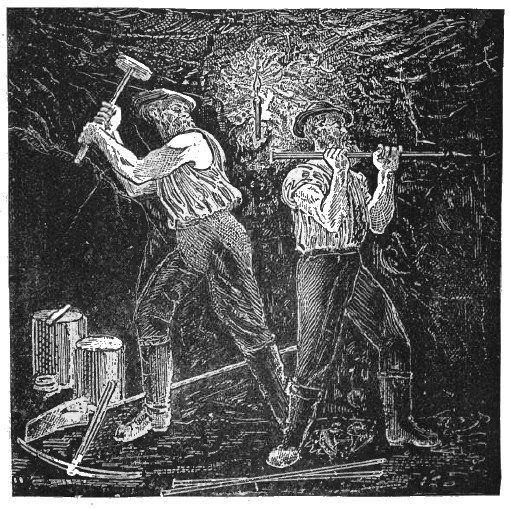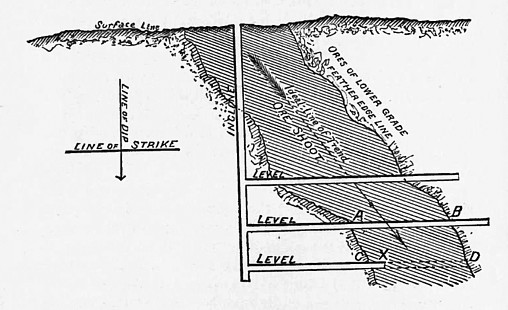Gold and silver miners use
many technical terms, and the articles on this website use those terms. To
better explain the meanings and definitions of these words, I have included
this glossary of mining terms to help the reader comprehend.
Adamantine. A mineral having diamond like luster.
Adit. A level, a horizontal drift or passage from the surface into a
mine.
Alluvium. A deposit of loose gravel between the surface and
subjacent rock.
Amalgam. Alloy combination of
gold or silver with mercury.
Analysis. A chemical search whereby the nature of a substance is
determined.
Aqua regia. A mixture of 3 parts hydrochloric acid with 1 part
strong nitric acid.
Apex. The top or highest point of a mineral deposit.
Argentiferous. Materials and ores containing silver.
Arenaceous. Having a sandy nature.
Argillaceous. Clay-bearing.
Arastras. A primitive rotary mill where rocks are dragged
around to crush ores.
Ascension. The theory that the matter filling fissures was
introduced from below.
Assay. To test ores by chemical extraction or blow-pipe examination.
Assay-ton. A sample with a weight of 29.166 2-3 grams.
Auriferous. Material containing gold.
Bar. A deposit of gravel in the bed of a river.
Bar-diggings. Claims on gravel deposits in the shallows of streams.
Base Metals. Those metals not classed as precious – lead, zinc,
copper, iron, etc.
Batea. A cone shaped gold-washing dish. Often used in Mexico and
South America.
Battery. A set of stamps for ore crushing – often arranged in groups
of four or five.
Bed. A horizontal seam or deposit of mineral.
Bed-rock. Solid stratum of rock lying below gravel and other
alluvial materials.
Blende. An old name for
sphalerite, an ore of zinc, consisting of zinc and sulfur.
Bonanza. A rich deposit of high grade ores; a bonanza mine yields a
large profit.
Booming. Placer mining using the sudden discharge of
accumulated water.
Boulders. Loose, rounded masses of stone.
Breast. The face of a tunnel or drift.
Calcite. Carbonate of lime; the main mineral in limestone rock.
Cap. A vein is in the "cap" when it is much contracted. Also the top
of a support post.
Carbonates. Salts of minerals containing carbonic acid, with lead is
Cerrusite.
Cheek. The side or wall of a vein.
Chimneys. The richer spots in lodes as distinguished from poorer
ones.
Cinnabar. The mineral name for the Sulfide of mercury.
cinnabar is a common ore.
Claim. The space of ground located and worked under the laws.
Chlorides. A compound of chlorine and silver.
Color. A small speck of placer gold.
Contact. A touching, meeting or junction of two substances, as
rocks.
Contact vein. A vein along the contact plane of, or between two
dissimilar rock masses.
Country. The ground traversed by a vein.
Country rock. The rock masses on each side of a vein.
Course of vein. -Along its length (see Strike).
Cradle. An old time mining apparatus; also called a rocker.
Crevice. A narrow opening, resulting from a split or crack in the
rock; a fissure.
Cribbing. The timber or plank lining of a shaft; the confining of
the wall-rock.
Cropping out. The rising of layers of rock to the surface.
Cross-cut. A level driven in a perpendicular direction across the
course of a vein.
Cupriferous. Copper bearing minerals and materials.
Cut. To intersect a vein; open cut, a level driven across the course
of a vein.
Debris. Fragments detached from rock or mountain.
Development. Work done in opening up access into a mine.
Descension. The theory that the material filling veins came in from
above.
Diggings. Name applied to placers being worked.
Dip. The slope, pitch or angle which a vein makes with the plane of
the horizon.
Diluvium. A deposit of superficial sand, loam, pebbles, gravel, etc.
Ditch. An artificial water-course dug in the earth ; a flume or
canal.
Dolly. A primitive hand operated stamp-mill for crushing ores.
Drift. A horizontal passage underground.
Dump. A place for deposit of tailings, or waste rock.
Dike. A wall-like mass of mineral matter filling fissures.
Exploitation. The working of a mine; the amount of work done.
Face. The end of a drift or tunnel.
Fault. A break caused by displacement of strata or veins so that
they are not continuous.
Feeder. A small vein joining a larger one.
Fissure vein. A fissure or crack in the earth's crust filled with
mineral matter.
Float. Loose rock or isolated masses of ore, or ore detached from
the original formation.
Float-gold. Fine sized grains of gold that do not sink in the
water.
Flux. Materials added to help fusion during melting or smelting.
Foliated. Rocks or materials found with a structure of thin layers.
Foot-wall. The layer of rock immediately under the vein.
Forfeiture. A failure to comply with the laws, prescribing the
quantity of work.
Galena. Lead ore; sulfur and lead. Galena is the chief
ore of lead.
Gangue. The substance inclosing and accompanying the ore in a vein.
Gash vein. A vein wide above and narrow below.
Geode. A stone containing a cavity studded with crystals or mineral
matter.
Gold. A natural, yellow-colored metal.
Gouge. A layer or separation of clay along a fault often between
vein and country rock.
Hanging wall. The layer of rock or wall over the top of a lode.
Heading. The vein above the drift.
Headings. In placer mining, the mass or gravel above the head of
sluice.
Horse. A mass of rock matter occurring in or between the branches of
a vein.
Hydraulicing. Washing down a placer claim by the use of hose or
"giant nozzle."
Impregnation. Metallic deposits having undefined limits and form.
Incline drift. An inclined passage underground.
Infiltration. The theory that vein-filling was introduced as mineral
water.
Injection. The theory that vein-filling was introduced by an igneous
fluid, and solidified.
In place. A vein or lode enclosed on both sides by fixed and
immovable rock.
Lagging. The timber over and upon the sides of a drift.
Length. A certain portion of the vein when taken on a horizontal
line.
Level. A horizontal passage or drift into a mine from a shaft.
Little Giant. A jointed iron nozzle used in placer mining.
Lode. Aggregations of mineral matter containing ores in fissures.
Long Tom. An older version of a sluice box, made for saving placer
gold.
Marl. Clay containing lime or limestone.
Matrix. The rock, or earthy matter containing a mineral or metallic
ore.
Metallurgy. The science of the reduction and processing of ores.
Mine. An excavation in the earth from which mineral substances are
dug.
Miner's Inch. A measure of flowing water, the exact amount being
set by local custom.
Mill-run. A test of a quantity of ore after reduction.
Nodule. A rounded mass of irregular shape.
Ores. Compounds of metals with oxygen, sulfur, arsenic, etc.
Outcrop. That portion of a vein appearing at the surface.
Patch. A small placer claim or area with a concentration of nuggets.
Placer. Gravel where gold is found; all forms of mineral deposits
except veins in place.
Plat. A claim map made on the basis of an original survey.
Pocket. A rich spot in a vein or deposit with a strong concentration
of valuable mineral.
Prospecting. Searching for new deposits, exploration to test the
value of lodes or placers.
Pulp.
Pulverized ore mixed with water; a flowing slurry mixture.
Quicksilver. An old name for Mercury, used in sluices to catch gold.
Reduce. To turn ore into metal by taking away oxygen.
Riffle. A groove or strip to catch gold and/or mercury in a sluice.
Riffle blocks. Wooden blocks set on end in a sluice, with
interstices for catching gold.
Segregations. Aggregations of ore having irregular form and definite
limits.
Selvage. Thin band of earthy matter between the vein and walls.
Shaft. A vertical well-like excavation in the earth which opens to
the surface.
Shift. The time for a miner's work, in one day or night.
Silver. A natural bright white metal.
Slickensides. Smooth, polished surfaces of walls caused by movement
on a fault.
Sluices. Boxes joined together, through which is washed auriferous
earth.
Smelting. Reducing the ores in furnaces to metals.
Stamps. Machines for crushing ores using a falling force.
Stope. An excavation removing the vein; to excavate in the form of
steps above a drift.
Stoping. The act of stoping or breaking down the surface of an
excavation with a pick.
Strata. A series of beds or layers of rock.
Strike. The extension of a lode in a horizontal direction.
Stulls. A framework, covered with timber or planks, to support the
walls of a stope.
Sublimation. The theory that the vein-matter was introduced in a
gaseous condition.
Sulfide. A mineral combination of sulfur and a metal.
Sump. That part of the shaft below the platform used for receiving
and collecting water.
Tailings. The waste matter discharged from the end of a sluice or
mine.
Throw. The movements of vein caused by a fault; it may be up, down
or side to side.
Tunnel. A level, driven at right angles to the vein, which its
object is to reach.
Vein. Aggregations of mineral matter in fissures of rocks.
Walls. The sides next to the lode.
Whim. A machine for raising or hoisting ores and waste by use of a
revolving drum.
Winze. An interior shaft sunk from one level to another.
Continue on to:
Old Time Gold Ore Processing Methods
Return To:
Hard Rock Quartz Mining and Milling


